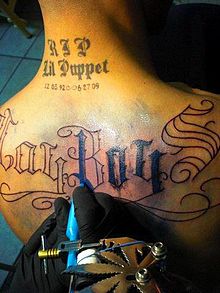Playboys (gang)

Playboy tattoo
|
|
| Years active | 1955 – present |
|---|---|
| Territory | Mostly in Los Angeles County California, the western and southern areas of the United States such as Arizona, New Mexico and Texas, Mexico, and Central America |
| Ethnicity | Predominantly Hispanic |
| Membership (est.) | Unknown but thought to be around 5–6,000 on the West Coast |
| Criminal activities | Drug trafficking, assault, robbery, extortion, arms trafficking, theft, murder, racketeering, illegal immigration, illegal gambling, and fraud |
| Allies | Mexican Mafia, Sureños, Aryan Brotherhood, Nazi Low Riders, Gulf Cartel, Mexican Klan 13, Townsmen 13, La Mirada Punks, Venice 13 |
| Rivals | Fresno Bulldogs, Florencia 13, Nortenos, Nuestra Familia, 18th Street, Clanton 14, MS-13, Crips, Bloods, Black Guerrilla Family, Texas Syndicate, Venice Shoreline Crips, Pirus, Asian Boyz |
Playboys 13 Gang, also known by the short name PBS13, is a violent, predominantly Hispanic street gang in West and East Los Angeles, California. They sometimes use the name Conejo or Rabbit gang. They align themselves with the Mexican Mafia, also known as La eme (which is Spanish for the letter M), while in prison and set aside their rivalry with other Sureño gangs. In some areas they refer to their houses and meeting or hang out areas as rabbit holes.
They began on the corner of Pico Boulevard and Fedora Street in West Los Angeles, California in the mid 1950s. They were originally a car club called, "Southern Califas Latin Playboys Car Club." Cliques from the West Side moved to Burbank, California in the 80's and have spread out to North Hollywood and other cities in the San Fernando Valley. Eastside Playboys started in 1975 on 49th street in Los Angeles, California and the Southside Playboys started in 1982 in Bell Gardens and South Gate, California. In the beginning they were all Hispanic, but in recent years, even though it is rare, other ethnic groups have been able to gain membership making them multiethnic. However, the Playboys remain predominantly Hispanic in all their cliques from Latin America to the United States.
The original Westside Playboys gang is still active in West Los Angeles, California despite a gang injunction against them. They have also had sightings in the Antelope Valley area in Southern California Their main territory is the area around the intersection of Pico Boulevard and Fedora Street in L.A.'s Olympic Division. Various other Playboys cliques have been established due to migration of members from Southern California to various other States. Yakima, Washington has one of the largest South Side Playboy Barrios outside of California. Recent reports place the Playboys Gang as far east as Memphis, Tennessee. The Westside Playboys have cliques in Burbank, North Hollywood, Palmdale, Canoga Park and Lancaster, California, while the Southside Playboys have cliques in Ensenada, Mexico; Eugene and Portland, Oregon; Omaha, Nebraska; and Tacoma, Washington. The Eastside Playboys stick mainly to their original territory with a clique in Fresno, California. The Eastside Playboys have an estimated 350–400 active members in California.
Although the Playboys are a Sureño gang and use the number 13 to show allegiance to the Mexican Mafia, they are rivals with most other Sureno gangs. The general thinking among Playboy gang members is that all other gangs are their enemy. The most identifiable tattoo all Playboys gang members and cliques use is the playboy bunny. They also use the playboy bunny logo in most of their graffiti with PBS around the head. The colors that are primarily used by the different subgroups of this gang are blue, but some of the gang's subgroups have taken other colors to identify themselves and give them their own unique individualism. The female subgroup known as the pink bunny clicka used the color pink and blue to represent themselves. However, many subgroups, like the pink bunny clicka, became inactive in the late 1990s. The Playboys, like many other Hispanic gangs, have a very strong sense of territory and family. In recent years the Playboys have been using the internet and various social networking sites to keep in contact with one another around the country.
...
Wikipedia
